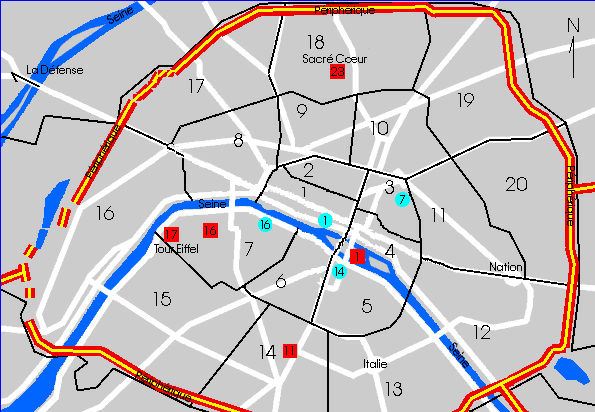
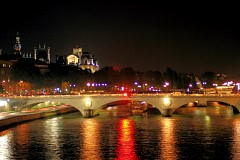
|
|
I thought I would experiment with some night photography. I had to lighten some of these
photographs. I took them over several nights. They
are roughly from the areas round-blue-1, round-blue-14, and square-red-1 in the
map at the left.
Above is le Pont (bridge) Saint-Michel - the imperial "N" is it's signature.
|
|
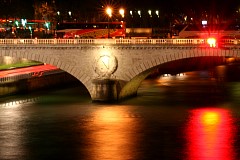
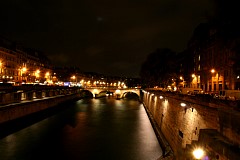
More pictures of le pont Saint-Michel. There has been a bridge in this spot linking the left bank to the Isle de la Cite since 1378.
The Isle de la Cite is the larger of the two islands in the Seine river in the center of
Paris. The bridge now here dates from 1857.
|
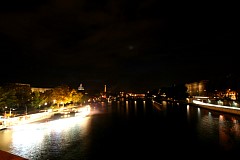
The view downstream - you can make out the blue-gray cupola of the Institute of France and the
Eiffel tower. Above the center of the river is a smudge of the full moon. When I first
thought of taking some night photos it was because there was going to be a full moon.
C'est la vie. The bright area in the lower left was caused
by a brightly lit boat going by while the camera shutter was open.
|
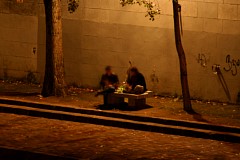
Below on one of the quays two figures sit.
|
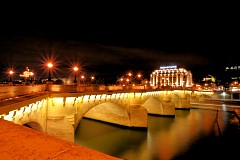
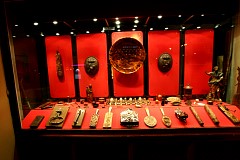
The first stone of the "Pont Neuf" (New Bridge) was laid in 1578. Across the river on the Right Bank is the
famous Paris department store La Samaritaine. It's closed for a security renovation. The rightmost
picture is a shop window taken across the street from the bridge. Enlarge it and look in
the reflection of the plate and you can make out the reversed letters "Samaritaine".
|
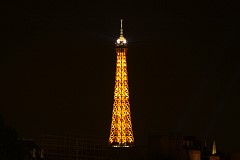
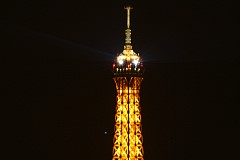
Obligatory shots of the Eiffel Tower.
|
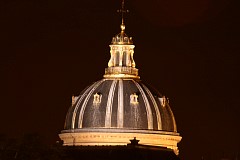
The cupola of the Institute of France (Institut de France). The Institute is composed of five academies -
the most famous one is the Académie française. It is housed by a palace financed by cardinal Mazarin.
In 1643 when Louis XIV ("The Sun King") was only a child, Mazarin
functioned essentially as the ruler of France. His modest manner contrasted with his immediate
predecessor and mentor, the imperious
Richelieu.
Cardinal Mazarin's wealth (he collected benefices and amassed a huge fortune and a greater collection of art than the king's) and his nieces' beauty, made for notable family connections, marital and extramarital.
His three nieces Ortensia, Maria and Olimpia, were famous for their wit, their beauty and their freedom. Olimpia was the mother of the famous Prince Eugene of Savoy. Ortensia was also a mistress of Charles II of England. Another niece Laura married Alfonso IV d'Este, Duke of Modena and was the mother of Mary of Modena, Queen of England.
|
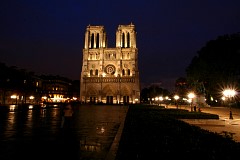
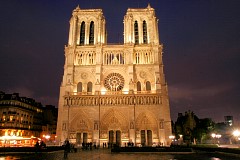
Notre Dame at night.
|
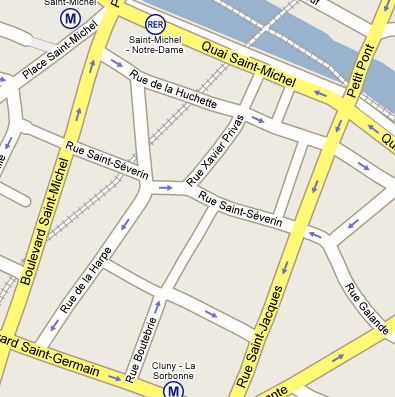
The Left Bank of the Seine - "left" if you were floating downstream - still has many of the
twisting lanes and narrow buildings of medieval times. The Right Bank is more modern
and business-oriented with wide boulevards and expensive shopping.
This map shows the so-called The Latin Quarter.
The name derives from the Latin language, which was widely spoken in the Middle Ages in
and near the University. The University of Paris (founded 1215), one of the leading universities of medieval Europe, was (and still is) nearby.
Place St. Michel is the traditional core of the Left Bank's artsy, liberal, hippie, bohemian district of poets, philosophers, and winos.
|
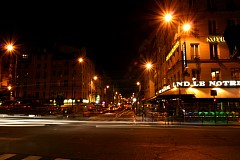
Looking down Rue St. Jacques. This street dates from about 1230 A.D..
|
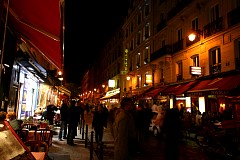
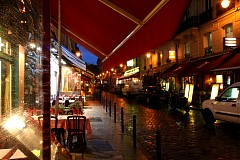
The nights are cool but not cold yet. These two pictures are taken in the
same location. You can see the plastic drape hanging from the awning
in the picture on the right. Most cafes have outdoor heaters set up so you can sit outside
of the cafe at a table in the chill air and yet still be warm.
|
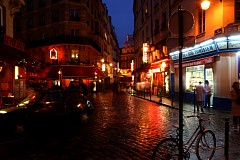
Unlike the remaining areas of Germany's medieval city centers, cars are still
permitted in the narrow streets of the Latin Quarter.
|
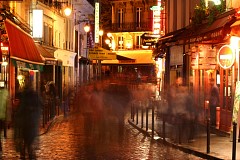
I like this picture - perhaps it illustrates man's fleeting existence when compared to
the more permanent nature of his dwellings? Or not ... In order to make these low-light
photographs the camera shutter has to be open for nearly 1/2 a minute. That allows things
like buildings etc. to show up. In the meantime, things that move - people - may not
show up because they are not in one spot long enough. They also may show up
as fleeting images, as they do here. It looks to me like another person is taking
pictures up at the end of the street - perhaps I am in their picture.
It also reminds me the first photo showing a human being was taken here in Paris.
|
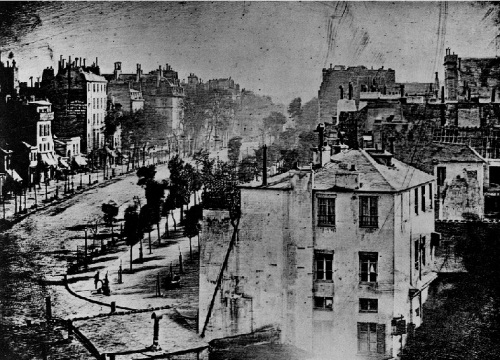
Louis-Jacques-Mandé Daguerre (1787-1851) was a French artist
and chemist.
This is "Boulevard du Temple", taken by Daguerre in late 1838
or early 1839 in Paris. The image showed a busy street, but because
exposure time was over ten minutes, the traffic was
too fleeting to appear. The exception is the man at
the bottom left, who stood still getting his boots
polished long enough to be in the picture - this unknown and long-gone
man is the first person ever photographed. (see enlargement below).
Daguerre first exposed
silver-coated copper plates to iodine, obtaining
silver iodide. Then he exposed them to light for
several minutes. Then he coated the plate with mercury
vapor heated to 75° Celsius, to amalgate the mercury
with the silver, finally fixing the image in salt
water.
The resultant plate produced a mirror-like exact
reproduction of the scene. The image was a mirror of
the original scene. The image could only be viewed at
an angle and needed protection from the air and
fingerprints so was encased in a glass-fronted box.
|
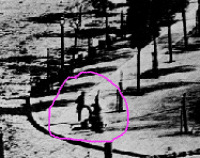
I have circled the foot-raised anonymous man getting his boots shined with.
He and his incarnation of our world is long gone.
|
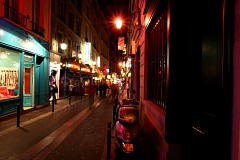
The shopping here is pretty much tourist kick-knacks.
|
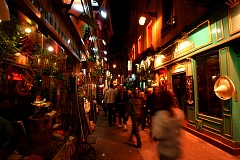
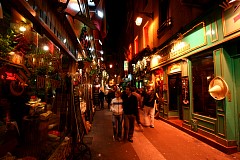
Pictures taken one after another show the varied foot traffic. Paris is a great place
to people-watch.
|

The man in the suit works for the restaurant - all the cafes and restaurants have someone
outside who calls to those passing by and tries to get them to come in and eat.
|
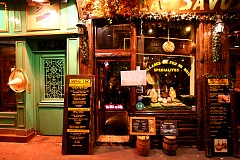
I was on a pretty tight budget. The cost of dinner at this time of night is the
most expensive. I ate once a day in the late afternoon when the prices were reduced.
It seems, though, that lots of people eat late at night.
|
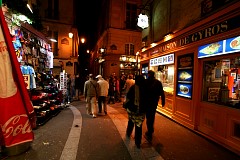
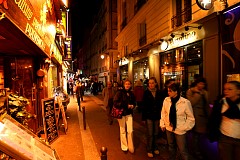
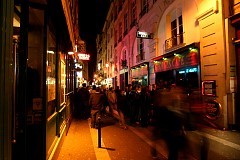
|
|
Just some random pictures to get the feeling of wandering around the Latin Quarter.
|
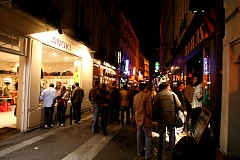
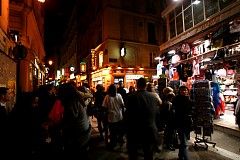
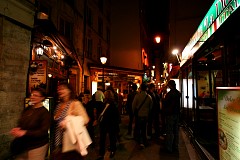
|